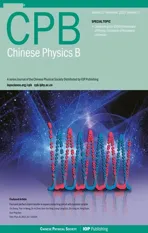Performance of the merged APPLE-Knot undulator for soft x-ray beamline in medium energy ring
2023-12-02RuiCheng成锐FaYuanZhang张发远HeMingZha查鹤鸣andShanQiao乔山
Rui Cheng(成锐), Fa-Yuan Zhang(张发远), He-Ming Zha(查鹤鸣), and Shan Qiao(乔山),3,†
1National Key Laboratory of Materials for Integrated Circuits,Shanghai Institute of Microsystem and Information Technology,Chinese Academy of Sciences,Shanghai 200050,China
2Center of Materials Science and Optoelectronics Engineering,University of Chinese Academy of Sciences,Beijing 100049,China
3School of Physical Science and Technology,ShanghaiTech University,Shanghai 201210,China
Keywords: synchrotron radiation,APPLE-Knot undulator,soft x-ray
1.Introduction
APPLE-Knot undulators,[1–4]inherited from APPLE[5,6]and Knot[7]undulators, have been proposed to solve the heat load problem of undulator with high deflection parameterK.The eight-row APPLE-Knot undulator proposed by Jiet al.[7]was proven to perform well in the vacuum ultraviolet beamline BL03U of Shanghai Synchrotron Radiation Facility (SSRF)with photon energy ranging from 7 eV to 300 eV.[8]Another structure proposed by Jiet al.is the merged APPLE-Knot undulator, which combines the APPLE and Knot magnets with vector addition of their magnetizations.[2]The merged APPLE-Knot undulator has higher performance and its structure is simpler.For both of Ji’s design, it was found that the polarization decreases when increase gap to generate high energy photons in vertical polarization mode.To solve this problem,Zhanget al.[4]proposed a better structure with increased size of merged magnets to reflect its larger magnetization and shifted-Knot-rows to achieve a balance between the horizontal and vertical polarization modes.For soft x-ray beamline in high energy rings,APPLE-Knot undulator also shows good performance.[9]Meanwhile, it is found that the shift of Knot parts led to a notable net kick for electrons in circular polarization mode.Yanget al.proposed a new structure to solve this problem by adjusting the size of the merged magnets without the shift of Knot rows and this method can also remedy the drop of polarization in vertical polarization mode.[10]For soft x-ray beamline in a medium energy ring, for example,a 3 GeV ring, because theKvalue needed is not so high,whether the APPLE-Knot undulator still excels APPLE undulator and what structure has better performance needs to be studied.Here the performance of APPLE-Knot undulator to generate soft x-ray in a 3.0 GeV storage ring is studied.Our calculations show that for fundamental harmonic in vertical polarization mode, either the increased size of merged magnets or the shift of the Knot part has little effect on the polarization.However, for higher harmonic, they both have a significant improvement in polarization.For linear polarization mode, the APPLE-Knot undulator shows similar performance as the APPLE undulator when generating fundamental harmonic and worse performance than the APPLE undulator when generating the third harmonic.For circular polarization mode, the APPLE-Knot undulator can cover a wider energy range,making it a better choice when circularly polarized photons with a broader energy range are needed,for example,for a magnetic circular dichroism beamline.
2.Performance of different structures of APPLE-Knot undulator
First, we investigate the performance of undulators with different structures.Figure 1(a) shows the structure with increased width of merged magnets.Figure 1(b)shows the structure with the increased width of merged magnets and shifted-Knot-rows.The following discussions are based on 3.0 GeV storage ring energy, 500 mA ring current, 16 mm minimum gap,4.5 m total undulator length and 260 eV to 2000 eV photon energy range.The root mean square errors of sizeσand divergence angleσ′of photons generated by undulators are
whereλandLare the photon wavelength and total length of the undulator,respectively.[11]In most cases discussed below except specially indicated, a 4σ′acceptance angle is chosen,in which 95% photons are included.The lengthcshown in Figs.1(a)and 1(b)is chosen as 6.55 mm so that the minimum energy of fundamental harmonic in all modes can be lower than 260 eV.For pure APPLE magnets(white cuboids),a saturated magnetic field near the axis is obtained when widthaand heightbare increased to 40 mm and 50 mm.For merged magnets(black cuboids),widtha′is selected as 50 mm to achieve the maximum photon flux in vertical polarization mode.The magnetization of the merged magnet is obtained by vector addition of magnetizations of the APPLE and Knot magnets and normalized to the remanent magnetization of the magnetic material.The ratios of magnetizations of the APPLE and Knot parts are chosen as 3.22 and 2.94 for structures in Figs.1(a)and 1(b), corresponding to a rotation angle of 17.22◦and 18.78◦,to achieve as high photon fluxes of the third harmonic as possible in both vertical and circular polarization modes while the on-axis heat load is below 100 W.The clearances between adjacent magnets are 3.5 mm in thexdirection and 0.5 mm in thezdirection.The magnetization of all the magnets is chosen as the remanent magnetization of NdFeB,which is 1.33 T.All the magnetic fields and radiation properties are calculated using the RADIA[12]and SPECTRA[13]programs.

Fig.1.Structures of a period of (a) APPLE-Knot undulator with larger merged magnets,(b)APPLE-Knot undulator with larger merged magnets and shifted-Knot-rows, (c) APPLE undulator.The black cuboids represent the merged magnets and the arrows represent the magnetization directions.
Both structures have similar performances in horizontal and circular polarization modes.In vertical polarization mode,they also perform similarly when generating the fundamental harmonic.The fluxes are almost the same and the polarizations can maintain above 99%.However,the difference occurs when generating the third harmonic.As shown in Fig.2, the polarization of the structure with shifted-Knot-rows is higher than 97.1%while the other is only 93.7%.So,the shift of the Knot rows is still necessary when higher vertical polarization of the third harmonic is needed.

Fig.2.Polarization of the third harmonic photons of different APPLEKnot undulator structures in vertical polarization mode.
3.Comparison with APPLE undulator in different modes
APPLE-Knot structure shown in Fig.1(b) is used for comparison in this section because of its better performance discussed before.The parametersa,b, andcof the APPLE undulator shown in Fig.1(c) are chosen as 40 mm, 50 mm and 6.6 mm to get less than 260 eV energy of fundamental harmonic in all modes and a saturated magnetic field near the axis.
When the rows of APPLE-Knot undulator at the positions are shown in Fig.1(b), it is in horizontal polarization mode and horizontally polarized photons will be produced.In this case, our calculations show that a high linear polarization in the 45◦direction relative to thexaxis (PL45) is get, which damages the horizontal polarization.By shifting row 2 and row 4 by-0.3λu/8 and 0.3λu/8 respectively in thezdirection, whereλuis the period of the APPLE part,PL45can be reduced to less than 1% and the horizontal polarization can reach 99.9% for all photon energies in different gaps.As shown in Fig.3(d), when the gap is set as 20 mm, the energy of fundamental harmonic can reach 256 eV.To switch from horizontal to vertical polarization mode,row 2 and row 4 need to be shifted by 4.5λu/8 and-4.5λu/8 to maximize the vertical polarization and minimizePL45at minimal gap.As shown in Fig.3(e), the energy of the fundamental harmonic can reach 252 eV for a 16 mm gap with a vertical polarization of 99.9%.The rows need to shift different values for different gaps to get maximum vertical polarizations.When open gap to 45 mm to increase the energy of the fundamental harmonic to 1269 eV,the shifts of row 2 and row 4 need to be changed to 4λu/8 and-4λu/8 to achieve a maximum vertical polarization of 99.8%.To switch from horizontal to circular polarization mode,row 2 and row 4 need to be shifted by 2.2λu/8 and 2.6λu/8 for a 18 mm gap.As shown in Fig.3(f), the energy of the fundamental harmonic is 254 eV with a circular polarization of 99.9%.When open gap to 45 mm to increase the energy of fundamental harmonic to 1247 eV,these shifts need to be changed to 2.4λu/8 and 2.8λu/8 to achieve a maximum circular polarization of 99.3%.Here, the rows also need to shift different values for different gaps to get maximum circular polarizations.

Fig.3.Magnetic fields and performance of APPLE-Knot undulator with the structure shown in Fig.1(b)at gaps of 20 mm,16 mm and 18 mm in horizontal,vertical and circular modes.(a)–(c)Magnetic fields in horizontal,vertical and circular polarization modes.(d)–(f)Fluxes(left axis)and polarizations(right axis)in horizontal,vertical and circular polarization modes at different photon energies.

Table 1.Main performances of APPLE and APPLE-Knot undulators in different polarization modes with normal 4σ′ acceptance angle.
Magnetic fields,fluxes and polarizations of APPLE-Knot undulator at gaps of 20 mm,16 mm and 18 mm in horizontal,vertical and circular modes are shown in Fig.3.Comparison of fluxes and heat loads of fundamental and the third harmonic photons between APPLE and APPLE-Knot undulators with 4σ′acceptance angle in different modes with different photon energies are shown in Fig.4.Main performances of APPLE and APPLE-Knot undulator are shown in Table 1.Electron velocities in thex–yplane of APPLE and APPLE-Knot undulators in different modes at gaps to generate fundamental harmonic with photon energy around 260 eV are shown in Fig.5.
For horizontal polarization mode, as shown in Fig.5(d),the electron beam velocities in thex–yplane always deviate from the undulator axis by greater than 0.1 mrad.As shown in Figs.4(a) and 4(d), the heat load inside the 0.093 mrad×0.093 mrad acceptance solid angle is 81 W at 256 eV,which is about 49%of APPLE undulator’s while the flux is about 90%of that of APPLE undulator.The flux of the third harmonic exceeds the fundamental one when the photon energy is higher than 1200 eV with a horizontal polarization of 99.8%.
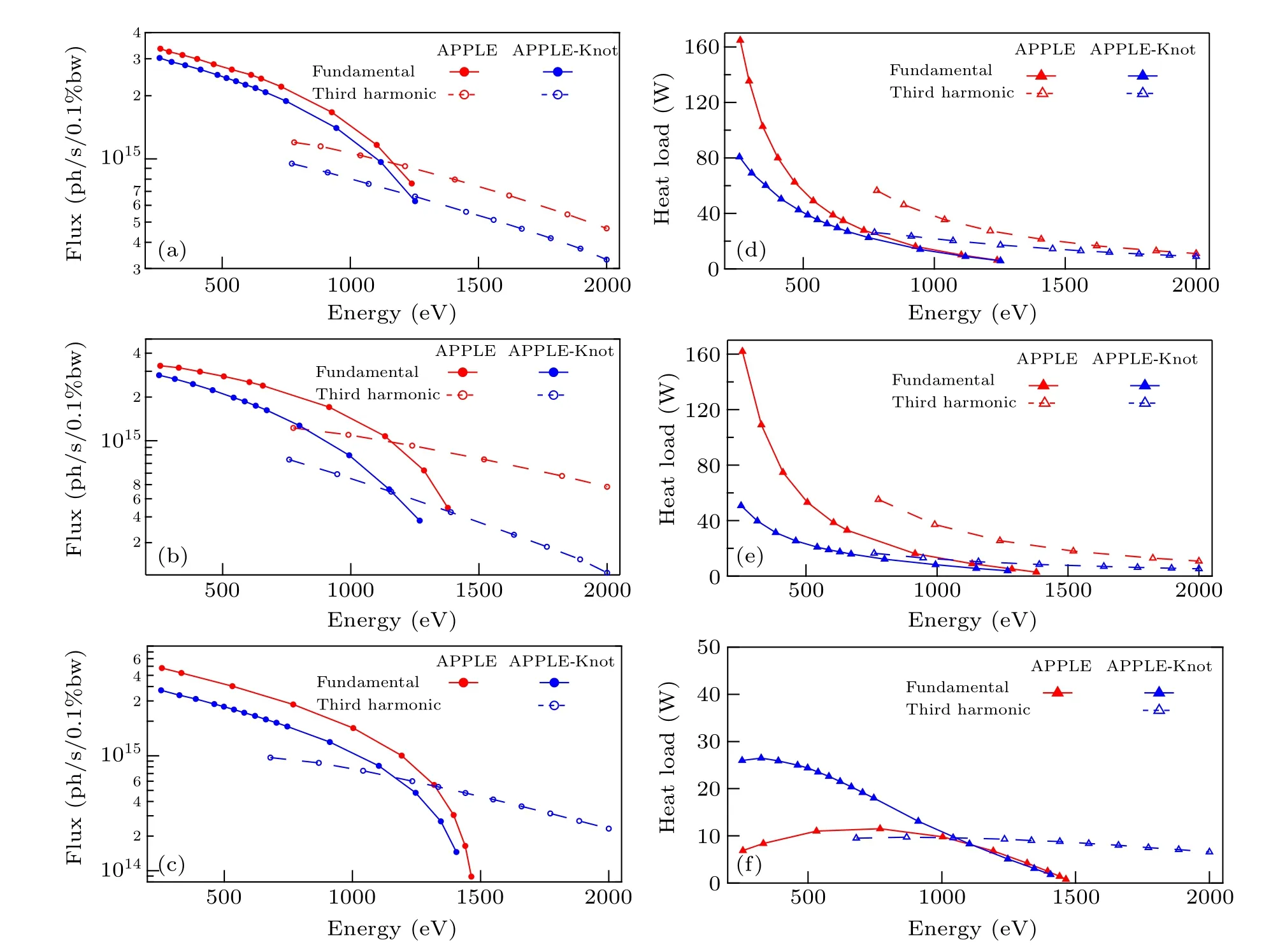
Fig.4.Fluxes and heat loads with 4σ′ acceptance angle at different photon energies of APPLE and APPLE-Knot undulators in different modes.(a)–(c)Fluxes of fundamental harmonic(solid line)and the third harmonic(dashed line)of APPLE(red)and APPLE-Knot(blue)undulators in horizontal,vertical and circular polarization modes.(d)–(f)Heat loads of fundamental harmonic(solid line)and the third harmonic(dashed line)of APPLE(red)and APPLE-Knot(blue)undulators in horizontal,vertical and circular polarization modes.
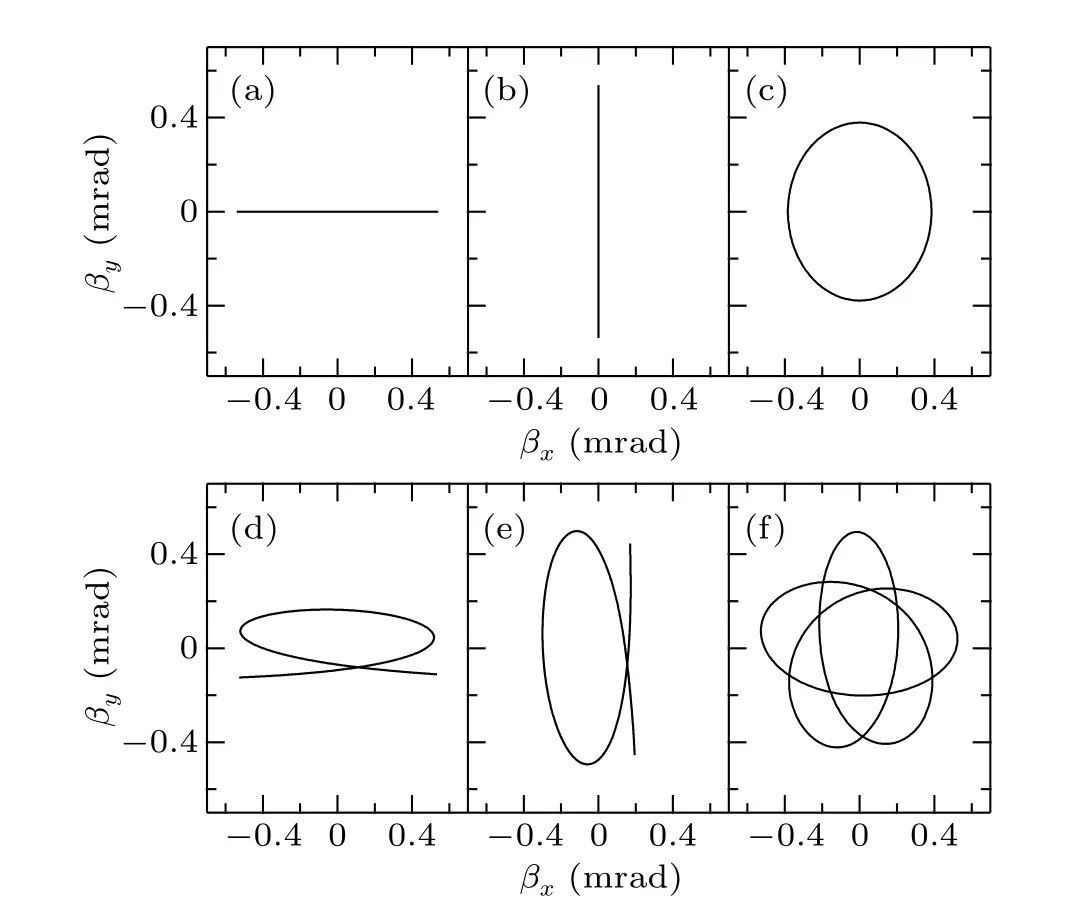
Fig.5.(a)–(c)Electron velocities in the x–y plane of APPLE undulator in horizontal,vertical and circular polarization modes.(d)–(f)Electron velocities in the x–y plane of APPLE-Knot undulator in horizontal,vertical and circular polarization modes.
For vertical polarization mode,as shown in Fig.5(e),the electron beam velocities in thex–yplane always deviate from the undulator axis by greater than 0.1 mrad.As shown in Fig.4(e),the heat load inside the 0.093 mrad×0.093 mrad acceptance solid angle is 51 W at 252 eV,which is about 31%of that of the APPLE undulator.As shown in Fig.4(b),the flux of APPLE-Knot undulator is about 85%of APPLE undulator’s at 252 eV and decreases to 45%at 1269 eV because of the imbalanced magnetic field in vertical polarization mode.As shown in Fig.6,the magnetic field of the APPLE part in vertical polarization mode (blue solid line) is weaker than that in horizontal polarization mode(red dashed line)while the Knot part is just the opposite.Too large magnetic field of the Knot part makes more photons go outside of the acceptance angle.The horizontal magnetic field component attenuates more quickly than the vertical magnetic field component when increasing the gap because the gap is always larger than the magnet clearance in thexdirection,and the situation becomes worse with a larger gap.A feasible way to solve this problem is widening the acceptance angle.When the acceptance solid angle increased to 5σ′(0.11 mrad)at 252 eV photon energy,the flux is the same as that of the APPLE undulator.Meanwhile, the vertical polarization is higher than 99% and the heat load is 71 W,which is only 43%of APPLE’s.
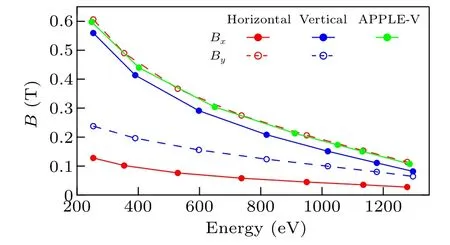
Fig.6.Maximum magnetic fields of APPLE-Knot undulator in horizontal(red),vertical(blue)polarization mode and APPLE undulator in vertical(green) polarization mode with different photon energies of the fundamental harmonic.
APPLE-Knot undulator diminishes the on-axis heat load by reducing the intensity of higher harmonics,which results in its weaker ability to generate on-axis third harmonic photons in linear polarization modes compared to the APPLE undulator.For the third harmonic in vertical polarization mode,as shown in Fig.4(b), the flux of APPLE-Knot undulator is about 60%of APPLE’s at 760 eV and decreases to about 26%at 2000 eV with 4σ′acceptance solid angles and the polarizations are always above 97.1%.By setting the acceptance angle as 0.129 mrad×0.129 mrad at all photon energies to get fluxes as high as possible and to maintain the heat load below 100 W,the flux becomes about 114%of APPLE undulator’s at 760 eV and decreases to 75%at 2000 eV as shown in Fig.7.Meanwhile the vertical polarization can always remain above 95.2%.

Fig.7.Fluxes(left axis)and heat loads(right axis)of the third harmonic of APPLE(red)and APPLE-Knot(blue)undulators in vertical polarization mode.Dashed lines,hollow circles and solid line,solid circles represent fluxes and heat loads of normal 4σ′and larger 0.129 mrad acceptance angles.
For circular polarization mode,as shown in Fig.4(f),the heat load of APPLE-Knot undulator inside the 0.093 mrad×0.093 mrad acceptance solid angle is 26 W at 254 eV, which is a bit higher than 6.9 W of APPLE undulator.Meanwhile,as shown in Fig.4(c), its flux is about 64% of APPLE undulator’s at 254 eV and increases to 81% at 1247 eV.Its circular polarization can remain above 99.3% for all photon energies.For circular polarization mode, the fluxes of the fundamental harmonic of both APPLE and APPLE-Knot undulators decrease quickly when increasing the gap.The APPLE undulator can only generate fundamental harmonic in circular polarization mode, which makes it cannot cover a broad photon energy range.However, the APPLE-Knot undulator has a considerable flux of the third harmonic in circular polarization mode because the distribution of electron velocities is distorted from perfect circular shape as shown in Fig.5(f).As shown in Fig.4(c), its flux of the third harmonic exceeds the fundamental one above 1200 eV photon energy and decreases to 2.3×1014ph/s/0.1%bw at 2000 eV with the circular polarization above 99.4%.To get a higher flux, it is still possible to increase the acceptance angle.As shown in Fig.8,with a larger 0.131 mrad×0.131 mrad acceptance angle, the flux of the third harmonic arises to 6.3×1014ph/s/0.1%bw at 2000 eV with the heat loads and circular polarizations always lower than 100 W and higher than 98.4%.

Fig.8.Fluxes(solid line,left axis)and heat loads(solid circles,right axis)of the third harmonic of APPLE-Knot undulator in circular polarization mode with 0.131 mrad acceptance angle.
4.Wide energy range in circular polarization mode
For APPLE undulator in circular polarization mode, the flux of the fundamental harmonic decreases rapidly with increasing gap.It is even worse that its third harmonic flux is negligibly small,which makes its narrow energy range a serious problem.APPLE-Knot undulator becomes a better choice when circularly polarized photons in a broad energy range are hoped.For example,at beamline 07U of SSRF,circularly polarized photons from 70 eV to 1900 eV are generated by two different APPLE-II type undulators for x-ray magnetic circular dichroism (XMCD) measurements.It is possible to use only one APPLE-Knot undulator to replace these two APPLE undulators with enough flux.In the following discussions, parameters of SSRF are used, which are 3.5 GeV storage ring energy and 300 mA ring current.Parametersa,b,andcof two APPLE undulators with the structure shown in Fig.1(c)area=70 mm,b=70 mm,c=9.45 mm for low energy range(APPLE1 undulator)anda=40 mm,b=50 mm,c=6.75 mm for high energy range(APPLE2 undulator)with 4.8 m total undulator length.The clearances between adjacent magnets are 3.5 mm in thexdirection, 1.8 mm and 0.5 mm in thezdirection,respectively.The minimum gaps are 21 mm and 16.5 mm,respectively.As shown in Fig.10(a),the fundamental harmonic can cover 70 eV–1200 eV for the low energy range and 275 eV–1900 eV for the high energy range.Circular polarization can remain above 99.9%for all photon energies.
Our calculations show that the original merged APPLEKnot undulator has better performance in generating the third harmonic in circular polarization mode.For both the original merged APPLE-Knot undulator and the one with shifted-Knot-rows structures,either larger or smaller width of merged magnets(a/=a′)results in a lower flux of the third harmonic in circularly polarized mode, so in the following discussion we only need to consider the case ofa=a′.With 4.8 m undulator length and 16 mm minimum gap, the parametersa,bandcof both undulators shown in Figs.1(a) and 1(b) area=a′=40 mm,b=50 mm,c=8.7 mm with the same considerations discussed before.The clearances between adjacent magnets are selected as 3.5 mm and 0.5 mm in thexandzdirections.The ratios between the magnetizations of the APPLE and Knot components are chosen as 3.57 and 4 respectively for original and shifted-Knot-rows undulators, which correspond to rotation angles of merged magnets as 15.65◦and 14.04◦to achieve maximum flux of the third harmonic at 1900 eV.Comparation of fluxes between the original merged APPLEKnot undulator and the one with shifted-Knot-rows is shown in Fig.9.For the original merged APPLE-Knot undulator,the flux of the fundamental harmonic is a bit lower than that with shifted-Knot-rows while the third harmonic is obviously higher.The flux of the third harmonic exceeds the fundamental one from 1400 eV photon energy.Circular polarization can remain above 99.3%.
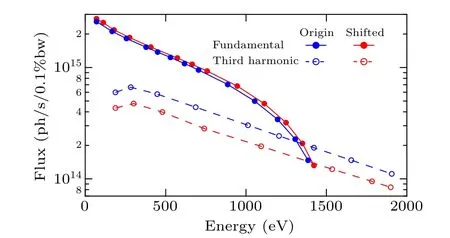
Fig.9.Comparation between the fluxes of the merged APPLE-Knot undulators in circular polarization mode with the original and shifted-Knotrows structures.
Comparation of fluxes of the original merged APPLEKnot undulator and two APPLE undulators with normal 4σ′acceptance angle is shown in Fig.10(a).The APPLE-Knot one can cover the whole energy range with fluxes higher than 1.1×1014ph/s/0.1%bm,higher than the minimum 1.0×1014ph/s/0.1%bm flux of APPLE’s.To increase the flux of the third harmonic of the APPLE-Knot undulator,a larger acceptance angle of about 15σ′can be chosen.The polarization is always above 96% and the heat load is below 100 W.The same acceptance angle is chosen for the APPLE undulator at a high energy range.As shown in Fig.10(b),though the flux of APPLE undulator is higher than that of APPLE-Knot for photons below 1890 eV, the decline rate of the third harmonic’s flux of APPLE-Knot is much smaller than that of the fundamental harmonic of APPLE undulator.Flux of APPLE-Knot undulator reaches 3.0×1014ph/s/0.1%bm at 1900 eV while that of APPLE is only 2.5×1014ph/s/0.1%bm.The above results clearly show that the APPLE-Knot undulator can cover a wider energy range.

Fig.10.Comparation between fluxes of two APPLE undulators and one APPLE-Knot undulator to generate circularly polarized photons with(a)normal 4σ′ and(b)larger 15σ′ acceptance angle.
5.Conclusion
For the APPLE-Knot undulator of soft x-ray beamline in a medium energy ring,shifted-Knot-rows are still necessary to get higher polarization of the third harmonic photons in vertical polarization mode.In horizontal polarization mode, its flux is almost the same as that of the APPLE undulator with a lower on-axis heat load.However, its flux in vertical mode is lower than that of the APPLE undulator, especially for the third harmonic,which makes it no advantage over the APPLE undulator, provided that the 160 W on-axis heat load of the APPLE undulator is not a serious problem.In circular polarization mode,the APPLE-Knot undulator has good performance to overcome the narrow energy range problem of the APPLE undulator, making it a better choice when broad energy range circular polarized photons are indispensable.
Acknowledgment
Project supported by the National Natural Science Foundation of China (Grant Nos.U1632266, 11927807, and U2032207).
杂志排行
Chinese Physics B的其它文章
- Optimal zero-crossing group selection method of the absolute gravimeter based on improved auto-regressive moving average model
- Deterministic remote preparation of multi-qubit equatorial states through dissipative channels
- Direct measurement of nonlocal quantum states without approximation
- Fast and perfect state transfer in superconducting circuit with tunable coupler
- A discrete Boltzmann model with symmetric velocity discretization for compressible flow
- Dynamic modelling and chaos control for a thin plate oscillator using Bubnov–Galerkin integral method
